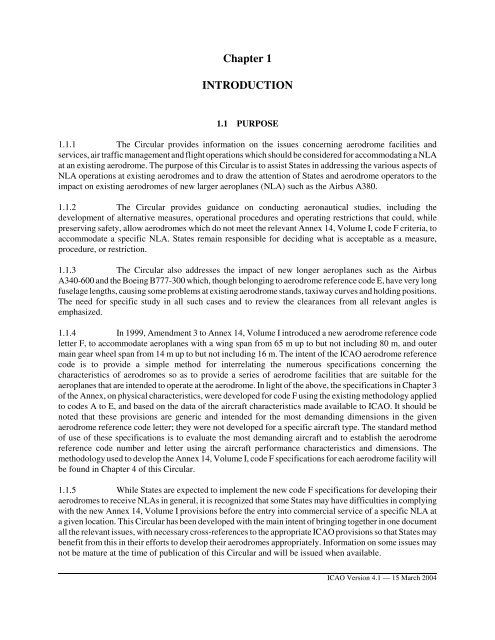Draft ICAO Circular on NLA.pdf - Airports Council International
Draft ICAO Circular on NLA.pdf - Airports Council International
Draft ICAO Circular on NLA.pdf - Airports Council International
You also want an ePaper? Increase the reach of your titles
YUMPU automatically turns print PDFs into web optimized ePapers that Google loves.
Chapter 1<br />
INTRODUCTION<br />
1.1 PURPOSE<br />
1.1.1 The <str<strong>on</strong>g>Circular</str<strong>on</strong>g> provides informati<strong>on</strong> <strong>on</strong> the issues c<strong>on</strong>cerning aerodrome facilities and<br />
services, air traffic management and flight operati<strong>on</strong>s which should be c<strong>on</strong>sidered for accommodating a <strong>NLA</strong><br />
at an existing aerodrome. The purpose of this <str<strong>on</strong>g>Circular</str<strong>on</strong>g> is to assist States in addressing the various aspects of<br />
<strong>NLA</strong> operati<strong>on</strong>s at existing aerodromes and to draw the attenti<strong>on</strong> of States and aerodrome operators to the<br />
impact <strong>on</strong> existing aerodromes of new larger aeroplanes (<strong>NLA</strong>) such as the Airbus A380.<br />
1.1.2 The <str<strong>on</strong>g>Circular</str<strong>on</strong>g> provides guidance <strong>on</strong> c<strong>on</strong>ducting aer<strong>on</strong>autical studies, including the<br />
development of alternative measures, operati<strong>on</strong>al procedures and operating restricti<strong>on</strong>s that could, while<br />
preserving safety, allow aerodromes which do not meet the relevant Annex 14, Volume I, code F criteria, to<br />
accommodate a specific <strong>NLA</strong>. States remain resp<strong>on</strong>sible for deciding what is acceptable as a measure,<br />
procedure, or restricti<strong>on</strong>.<br />
1.1.3 The <str<strong>on</strong>g>Circular</str<strong>on</strong>g> also addresses the impact of new l<strong>on</strong>ger aeroplanes such as the Airbus<br />
A340-600 and the Boeing B777-300 which, though bel<strong>on</strong>ging to aerodrome reference code E, have very l<strong>on</strong>g<br />
fuselage lengths, causing some problems at existing aerodrome stands, taxiway curves and holding positi<strong>on</strong>s.<br />
The need for specific study in all such cases and to review the clearances from all relevant angles is<br />
emphasized.<br />
1.1.4 In 1999, Amendment 3 to Annex 14, Volume I introduced a new aerodrome reference code<br />
letter F, to accommodate aeroplanes with a wing span from 65 m up to but not including 80 m, and outer<br />
main gear wheel span from 14 m up to but not including 16 m. The intent of the <str<strong>on</strong>g>ICAO</str<strong>on</strong>g> aerodrome reference<br />
code is to provide a simple method for interrelating the numerous specificati<strong>on</strong>s c<strong>on</strong>cerning the<br />
characteristics of aerodromes so as to provide a series of aerodrome facilities that are suitable for the<br />
aeroplanes that are intended to operate at the aerodrome. In light of the above, the specificati<strong>on</strong>s in Chapter 3<br />
of the Annex, <strong>on</strong> physical characteristics, were developed for code F using the existing methodology applied<br />
to codes A to E, and based <strong>on</strong> the data of the aircraft characteristics made available to <str<strong>on</strong>g>ICAO</str<strong>on</strong>g>. It should be<br />
noted that these provisi<strong>on</strong>s are generic and intended for the most demanding dimensi<strong>on</strong>s in the given<br />
aerodrome reference code letter; they were not developed for a specific aircraft type. The standard method<br />
of use of these specificati<strong>on</strong>s is to evaluate the most demanding aircraft and to establish the aerodrome<br />
reference code number and letter using the aircraft performance characteristics and dimensi<strong>on</strong>s. The<br />
methodology used to develop the Annex 14, Volume I, code F specificati<strong>on</strong>s for each aerodrome facility will<br />
be found in Chapter 4 of this <str<strong>on</strong>g>Circular</str<strong>on</strong>g>.<br />
1.1.5 While States are expected to implement the new code F specificati<strong>on</strong>s for developing their<br />
aerodromes to receive <strong>NLA</strong>s in general, it is recognized that some States may have difficulties in complying<br />
with the new Annex 14, Volume I provisi<strong>on</strong>s before the entry into commercial service of a specific <strong>NLA</strong> at<br />
a given locati<strong>on</strong>. This <str<strong>on</strong>g>Circular</str<strong>on</strong>g> has been developed with the main intent of bringing together in <strong>on</strong>e document<br />
all the relevant issues, with necessary cross-references to the appropriate <str<strong>on</strong>g>ICAO</str<strong>on</strong>g> provisi<strong>on</strong>s so that States may<br />
benefit from this in their efforts to develop their aerodromes appropriately. Informati<strong>on</strong> <strong>on</strong> some issues may<br />
not be mature at the time of publicati<strong>on</strong> of this <str<strong>on</strong>g>Circular</str<strong>on</strong>g> and will be issued when available.<br />
<str<strong>on</strong>g>ICAO</str<strong>on</strong>g> Versi<strong>on</strong> 4.1 — 15 March 2004

















